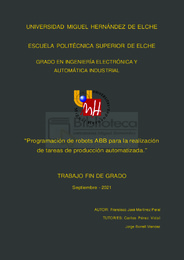Por favor, use este identificador para citar o enlazar este ítem:
https://hdl.handle.net/11000/26488Registro completo de metadatos
| Campo DC | Valor | Lengua/Idioma |
|---|---|---|
| dc.contributor.advisor | Pérez Vidal, Carlos | - |
| dc.contributor.advisor | Borrell Méndez, Jorge | - |
| dc.contributor.author | Martínez Peral, Francisco José | - |
| dc.contributor.other | Departamentos de la UMH::Ingeniería de Sistemas y Automática | es_ES |
| dc.date.accessioned | 2022-04-05T11:17:24Z | - |
| dc.date.available | 2022-04-05T11:17:24Z | - |
| dc.date.created | 2021-09-16 | - |
| dc.identifier.uri | http://hdl.handle.net/11000/26488 | - |
| dc.description.abstract | El presente trabajo se basa principalmente en dos partes. La primera, pretende diseñar y programar una estación robótica la cual realiza un proceso de Pick&Place de plantillas de zapatos y su posterior clasificación. La segunda parte , se basa en la programación de un programa usando Python para la obtención de datos a partir de archivos de AutoCAD y su envío directamente al robot con lo que conseguiremos una mayor automatización del proceso. Primero, realizaremos un estudio del estado del arte actual en el uso de robots paralelos, los cuales han sido los elegidos para este proyecto. El siguiente paso será realizar un breve tutorial del funcionamiento de RAPID y RobotStudio. Adquiridos estos conocimientos, se diseñará la estación virtual mediante RobotStudio. Dicha estación realizará el proceso de corte de planchas de un material mediante una máquina CNC y a continuación, gracias a una cinta transportadora, estas plantillas serán transportadas hasta la posición de recogida, donde los robots, suspendidos en un pórtico sobre la cinta, serán los encargados de realizar la tarea de Pick&Place y su posterior clasificación y colocación de las plantillas. Finalmente, nos centraremos en la simulación de la estación, con el análisis y evaluación del resultado obtenido para comprobar su correcto funcionamiento. En la segunda parte del proyecto, pasaremos a diseñar un programa en Python para leer los archivos obtenidos de una maquina CNC con el diseño del corte realizado, proporcionados por la empresa Comelz y con los que se obtendrán los datos de posición, rotación, y el nombre de cada uno de los modelos de plantillas presentes en el fichero. Estos datos serán enviados mediante un socket al robot en RobotStudio. Con estos datos, el robot será capaz de realizar la tarea de Pick&Place de una forma más automatizada y su posterior clasificación. | es_ES |
| dc.description.abstract | This work is mainly based on two parts. The first part aims to design and program a robotic station which performs a Pick&Place process of shoe insoles and their subsequent classification. The second part is based on the programming of a program using Python to obtain data from AutoCAD files and send them directly to the robot, thus achieving greater automation of the process. First, we will carry out a study of the current state of the art in the use of parallel robots, which have been chosen for this project. The next step will be to carry out a brief tutorial on the operation of RAPID and RobotStudio. Once this knowledge has been acquired, the virtual station will be designed using RobotStudio. This station will carry out the process of cutting sheets of a material using a CNC machine and then, thanks to a conveyor belt, these templates will be transported to the pick-up position, where the robots, suspended on a gantry above the belt, will be in charge of carrying out the Pick&Place task and their subsequent classification and placement of the templates. Finally, we will focus on the simulation of the station, with the analysis and evaluation of the result obtained to check its correct operation. In the second part of the project, we will design a Python program to read the files obtained from a CNC machine with the design of the cut made, provided by the company Comelz and with which we will obtain the position data, rotation, and the name of each of the template models present in the file. This data will be sent via a socket to the robot in RobotStudio. With this data, the robot will be able to perform the Pick&Place task in a more automated way and its subsequent classification. | es_ES |
| dc.format | application/pdf | es_ES |
| dc.format.extent | 154 | es_ES |
| dc.language.iso | spa | es_ES |
| dc.publisher | Universidad Miguel Hernández de Elche | es_ES |
| dc.rights | info:eu-repo/semantics/openAccess | es_ES |
| dc.rights | Attribution-NonCommercial-NoDerivatives 4.0 Internacional | * |
| dc.rights.uri | http://creativecommons.org/licenses/by-nc-nd/4.0/ | * |
| dc.subject | ABB | es_ES |
| dc.subject | controlador | es_ES |
| dc.subject | estación robotizada | es_ES |
| dc.subject | proceso industrial | es_ES |
| dc.subject | robot paralelo | es_ES |
| dc.subject | programación RAPID | es_ES |
| dc.subject | controller | es_ES |
| dc.subject | robotic station | es_ES |
| dc.subject | industrial process | es_ES |
| dc.subject | parallel robot | es_ES |
| dc.subject | RAPID programming | es_ES |
| dc.subject | RobotStudio | es_ES |
| dc.subject.other | CDU::6 - Ciencias aplicadas::62 - Ingeniería. Tecnología | es_ES |
| dc.title | Programación de robots ABB para la realización de tareas de producción automatizada | es_ES |
| dc.type | info:eu-repo/semantics/bachelorThesis | es_ES |

Ver/Abrir:
TFG-Martínez Peral, Francisco José.pdf
14,2 MB
Adobe PDF
Compartir:
 La licencia se describe como: Atribución-NonComercial-NoDerivada 4.0 Internacional.
La licencia se describe como: Atribución-NonComercial-NoDerivada 4.0 Internacional.
.png)